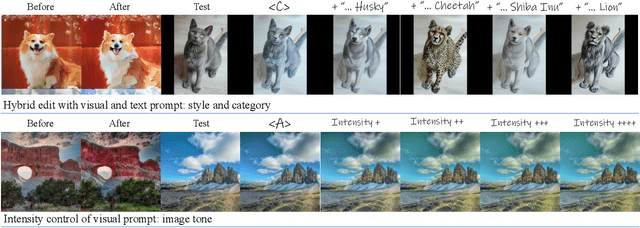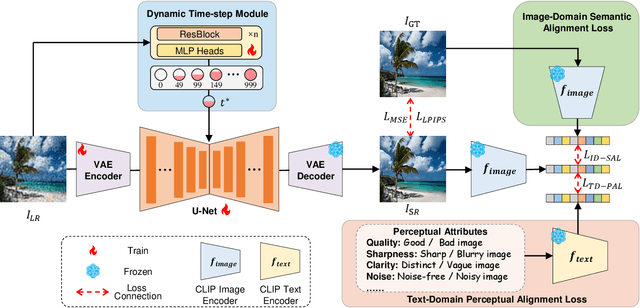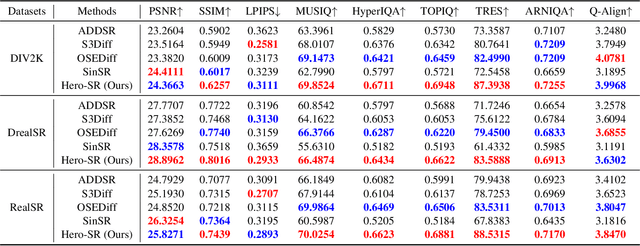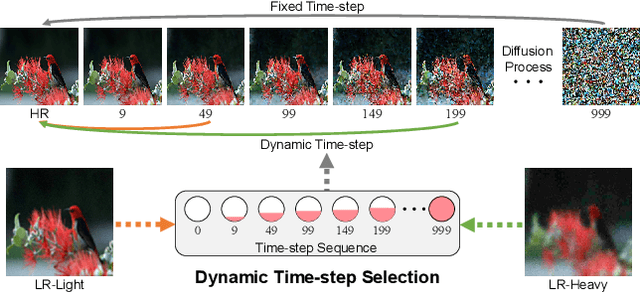Qingnan Fan
Restore Text First, Enhance Image Later: Two-Stage Scene Text Image Super-Resolution with Glyph Structure Guidance
Oct 24, 2025Abstract:Current generative super-resolution methods show strong performance on natural images but distort text, creating a fundamental trade-off between image quality and textual readability. To address this, we introduce \textbf{TIGER} (\textbf{T}ext-\textbf{I}mage \textbf{G}uided sup\textbf{E}r-\textbf{R}esolution), a novel two-stage framework that breaks this trade-off through a \textit{"text-first, image-later"} paradigm. \textbf{TIGER} explicitly decouples glyph restoration from image enhancement: it first reconstructs precise text structures and then uses them to guide subsequent full-image super-resolution. This glyph-to-image guidance ensures both high fidelity and visual consistency. To support comprehensive training and evaluation, we also contribute the \textbf{UltraZoom-ST} (UltraZoom-Scene Text), the first scene text dataset with extreme zoom (\textbf{$\times$14.29}). Extensive experiments show that \textbf{TIGER} achieves \textbf{state-of-the-art} performance, enhancing readability while preserving overall image quality.
TinySR: Pruning Diffusion for Real-World Image Super-Resolution
Aug 24, 2025Abstract:Real-world image super-resolution (Real-ISR) focuses on recovering high-quality images from low-resolution inputs that suffer from complex degradations like noise, blur, and compression. Recently, diffusion models (DMs) have shown great potential in this area by leveraging strong generative priors to restore fine details. However, their iterative denoising process incurs high computational overhead, posing challenges for real-time applications. Although one-step distillation methods, such as OSEDiff and TSD-SR, offer faster inference, they remain fundamentally constrained by their large, over-parameterized model architectures. In this work, we present TinySR, a compact yet effective diffusion model specifically designed for Real-ISR that achieves real-time performance while maintaining perceptual quality. We introduce a Dynamic Inter-block Activation and an Expansion-Corrosion Strategy to facilitate more effective decision-making in depth pruning. We achieve VAE compression through channel pruning, attention removal and lightweight SepConv. We eliminate time- and prompt-related modules and perform pre-caching techniques to further speed up the model. TinySR significantly reduces computational cost and model size, achieving up to 5.68x speedup and 83% parameter reduction compared to its teacher TSD-SR, while still providing high quality results.
BokehDiff: Neural Lens Blur with One-Step Diffusion
Jul 24, 2025Abstract:We introduce BokehDiff, a novel lens blur rendering method that achieves physically accurate and visually appealing outcomes, with the help of generative diffusion prior. Previous methods are bounded by the accuracy of depth estimation, generating artifacts in depth discontinuities. Our method employs a physics-inspired self-attention module that aligns with the image formation process, incorporating depth-dependent circle of confusion constraint and self-occlusion effects. We adapt the diffusion model to the one-step inference scheme without introducing additional noise, and achieve results of high quality and fidelity. To address the lack of scalable paired data, we propose to synthesize photorealistic foregrounds with transparency with diffusion models, balancing authenticity and scene diversity.
Text-Aware Real-World Image Super-Resolution via Diffusion Model with Joint Segmentation Decoders
Jun 05, 2025Abstract:The introduction of generative models has significantly advanced image super-resolution (SR) in handling real-world degradations. However, they often incur fidelity-related issues, particularly distorting textual structures. In this paper, we introduce a novel diffusion-based SR framework, namely TADiSR, which integrates text-aware attention and joint segmentation decoders to recover not only natural details but also the structural fidelity of text regions in degraded real-world images. Moreover, we propose a complete pipeline for synthesizing high-quality images with fine-grained full-image text masks, combining realistic foreground text regions with detailed background content. Extensive experiments demonstrate that our approach substantially enhances text legibility in super-resolved images, achieving state-of-the-art performance across multiple evaluation metrics and exhibiting strong generalization to real-world scenarios. Our code is available at \href{https://github.com/mingcv/TADiSR}{here}.
Textualize Visual Prompt for Image Editing via Diffusion Bridge
Jan 07, 2025



Abstract:Visual prompt, a pair of before-and-after edited images, can convey indescribable imagery transformations and prosper in image editing. However, current visual prompt methods rely on a pretrained text-guided image-to-image generative model that requires a triplet of text, before, and after images for retraining over a text-to-image model. Such crafting triplets and retraining processes limit the scalability and generalization of editing. In this paper, we present a framework based on any single text-to-image model without reliance on the explicit image-to-image model thus enhancing the generalizability and scalability. Specifically, by leveraging the probability-flow ordinary equation, we construct a diffusion bridge to transfer the distribution between before-and-after images under the text guidance. By optimizing the text via the bridge, the framework adaptively textualizes the editing transformation conveyed by visual prompts into text embeddings without other models. Meanwhile, we introduce differential attention control during text optimization, which disentangles the text embedding from the invariance of the before-and-after images and makes it solely capture the delicate transformation and generalize to edit various images. Experiments on real images validate competitive results on the generalization, contextual coherence, and high fidelity for delicate editing with just one image pair as the visual prompt.
CoMPaSS: Enhancing Spatial Understanding in Text-to-Image Diffusion Models
Dec 17, 2024



Abstract:Text-to-image diffusion models excel at generating photorealistic images, but commonly struggle to render accurate spatial relationships described in text prompts. We identify two core issues underlying this common failure: 1) the ambiguous nature of spatial-related data in existing datasets, and 2) the inability of current text encoders to accurately interpret the spatial semantics of input descriptions. We address these issues with CoMPaSS, a versatile training framework that enhances spatial understanding of any T2I diffusion model. CoMPaSS solves the ambiguity of spatial-related data with the Spatial Constraints-Oriented Pairing (SCOP) data engine, which curates spatially-accurate training data through a set of principled spatial constraints. To better exploit the curated high-quality spatial priors, CoMPaSS further introduces a Token ENcoding ORdering (TENOR) module to allow better exploitation of high-quality spatial priors, effectively compensating for the shortcoming of text encoders. Extensive experiments on four popular open-weight T2I diffusion models covering both UNet- and MMDiT-based architectures demonstrate the effectiveness of CoMPaSS by setting new state-of-the-arts with substantial relative gains across well-known benchmarks on spatial relationships generation, including VISOR (+98%), T2I-CompBench Spatial (+67%), and GenEval Position (+131%). Code will be available at https://github.com/blurgyy/CoMPaSS.
SLAM3R: Real-Time Dense Scene Reconstruction from Monocular RGB Videos
Dec 12, 2024Abstract:In this paper, we introduce \textbf{SLAM3R}, a novel and effective monocular RGB SLAM system for real-time and high-quality dense 3D reconstruction. SLAM3R provides an end-to-end solution by seamlessly integrating local 3D reconstruction and global coordinate registration through feed-forward neural networks. Given an input video, the system first converts it into overlapping clips using a sliding window mechanism. Unlike traditional pose optimization-based methods, SLAM3R directly regresses 3D pointmaps from RGB images in each window and progressively aligns and deforms these local pointmaps to create a globally consistent scene reconstruction - all without explicitly solving any camera parameters. Experiments across datasets consistently show that SLAM3R achieves state-of-the-art reconstruction accuracy and completeness while maintaining real-time performance at 20+ FPS. Code and weights at: \url{https://github.com/PKU-VCL-3DV/SLAM3R}.
Reloc3r: Large-Scale Training of Relative Camera Pose Regression for Generalizable, Fast, and Accurate Visual Localization
Dec 11, 2024Abstract:Visual localization aims to determine the camera pose of a query image relative to a database of posed images. In recent years, deep neural networks that directly regress camera poses have gained popularity due to their fast inference capabilities. However, existing methods struggle to either generalize well to new scenes or provide accurate camera pose estimates. To address these issues, we present \textbf{Reloc3r}, a simple yet effective visual localization framework. It consists of an elegantly designed relative pose regression network, and a minimalist motion averaging module for absolute pose estimation. Trained on approximately 8 million posed image pairs, Reloc3r achieves surprisingly good performance and generalization ability. We conduct extensive experiments on 6 public datasets, consistently demonstrating the effectiveness and efficiency of the proposed method. It provides high-quality camera pose estimates in real time and generalizes to novel scenes. Code, weights, and data at: \url{https://github.com/ffrivera0/reloc3r}.
Hero-SR: One-Step Diffusion for Super-Resolution with Human Perception Priors
Dec 10, 2024



Abstract:Owing to the robust priors of diffusion models, recent approaches have shown promise in addressing real-world super-resolution (Real-SR). However, achieving semantic consistency and perceptual naturalness to meet human perception demands remains difficult, especially under conditions of heavy degradation and varied input complexities. To tackle this, we propose Hero-SR, a one-step diffusion-based SR framework explicitly designed with human perception priors. Hero-SR consists of two novel modules: the Dynamic Time-Step Module (DTSM), which adaptively selects optimal diffusion steps for flexibly meeting human perceptual standards, and the Open-World Multi-modality Supervision (OWMS), which integrates guidance from both image and text domains through CLIP to improve semantic consistency and perceptual naturalness. Through these modules, Hero-SR generates high-resolution images that not only preserve intricate details but also reflect human perceptual preferences. Extensive experiments validate that Hero-SR achieves state-of-the-art performance in Real-SR. The code will be publicly available upon paper acceptance.
RAP-SR: RestorAtion Prior Enhancement in Diffusion Models for Realistic Image Super-Resolution
Dec 10, 2024



Abstract:Benefiting from their powerful generative capabilities, pretrained diffusion models have garnered significant attention for real-world image super-resolution (Real-SR). Existing diffusion-based SR approaches typically utilize semantic information from degraded images and restoration prompts to activate prior for producing realistic high-resolution images. However, general-purpose pretrained diffusion models, not designed for restoration tasks, often have suboptimal prior, and manually defined prompts may fail to fully exploit the generated potential. To address these limitations, we introduce RAP-SR, a novel restoration prior enhancement approach in pretrained diffusion models for Real-SR. First, we develop the High-Fidelity Aesthetic Image Dataset (HFAID), curated through a Quality-Driven Aesthetic Image Selection Pipeline (QDAISP). Our dataset not only surpasses existing ones in fidelity but also excels in aesthetic quality. Second, we propose the Restoration Priors Enhancement Framework, which includes Restoration Priors Refinement (RPR) and Restoration-Oriented Prompt Optimization (ROPO) modules. RPR refines the restoration prior using the HFAID, while ROPO optimizes the unique restoration identifier, improving the quality of the resulting images. RAP-SR effectively bridges the gap between general-purpose models and the demands of Real-SR by enhancing restoration prior. Leveraging the plug-and-play nature of RAP-SR, our approach can be seamlessly integrated into existing diffusion-based SR methods, boosting their performance. Extensive experiments demonstrate its broad applicability and state-of-the-art results. Codes and datasets will be available upon acceptance.
 Add to Chrome
Add to Chrome Add to Firefox
Add to Firefox Add to Edge
Add to Edge